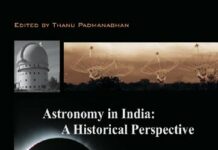
Ebook Info
- Published: 2016
- Number of pages: 300 pages
- Format: PDF
- File Size: 4.01 MB
- Authors: Thanu Padmanabhan
Description
This book describes, in clear terms, the Why, What and the How of Quantum Field Theory. The raison d’etre of QFT is explained by starting from the dynamics of a relativistic particle and demonstrating how it leads to the notion of quantum fields. Non-perturbative aspects and the Wilsonian interpretation of field theory are emphasized right from the start. Several interesting topics such as the Schwinger effect, Davies-Unruh effect, Casimir effect and spontaneous symmetry breaking introduce the reader to the elegance and breadth of applicability of field theoretical concepts. Complementing the conceptual aspects, the book also develops all the relevant mathematical techniques in detail, leading e.g., to the computation of anomalous magnetic moment of the electron and the two-loop renormalisation of the self-interacting scalar field. It contains nearly a hundred problems, of varying degrees of difficulty, making it suitable for both self-study and classroom use.
User’s Reviews
Editorial Reviews: Review “The readership of this book consists of graduate students and researchers alike. … Full of valuable insight, this modern treatise is sure to become a classic text on a subject of central importance.” (Gert Roepstorff, zbMATH 1338.81002, 2016) From the Back Cover This book describes, in clear terms, the Why, What and the How of Quantum Field Theory. The raison d’etre of QFT is explained by starting from the dynamics of a relativistic particle and demonstrating how it leads to the notion of quantum fields. Non-perturbative aspects and the Wilsonian interpretation of field theory are emphasized right from the start. Several interesting topics such as the Schwinger effect, Davies-Unruh effect, Casimir effect and spontaneous symmetry breaking introduce the reader to the elegance and breadth of applicability of field theoretical concepts. Complementing the conceptual aspects, the book also develops all the relevant mathematical techniques in detail, leading e.g., to the computation of anomalous magnetic moment of the electron and the two-loop renormalisation of the self-interacting scalar field. It contains nearly a hundred problems, of varying degrees of difficulty, making it suitable for both self-study and classroom use. About the Author Thanu Padmanabhan, currently Distinguished Professor at the Inter-University Centre for Astronomy and Astrophysics at Pune, India, is a theoretical physicist whose research spans a wide variety of topics in gravitation, cosmology and quantum gravity. He has authored 10 books and about 250 papers and reviews, many of which have had significant impact in their fields. He was a Sackler Distinguished Astronomer of IoA, Cambridge, the President of the Cosmology Commission of the International Astronomical Union and the Chairman of the Astrophysics Commission of the International Union of Pure and Applied Physics and the recipient of Padma Shri, the Presidential medal which is the fourth highest civilian honor in India. Read more
Reviews from Amazon users which were colected at the time this book was published on the website:
⭐I love this book. The first chapter is totally amazing, it explains many doubts that I had about quantum field theory. The beauty of this book resides in its different approach to explain the concepts of quantum field theory. It is not only “shut up and calculate,” it is about the conceptual foundation of this topic, and that is the key for me.My recipe to learn quantum field theory (At least, until quantum electrodynamics) is this books plus student friendly quantum field theory (Klauber). Padmanabhan’s book puts more emphasis on path integral formulation. On the contrary, Klauber’s book is about canonical quantization. Therefore, with these two books, you can dominate both formulations, and you will be prepared for gauge theory and the standard model. (QCD and electroweak interaction).There are many books about QFT, but most of them are a waste of time from my point of view. Why did I want to learn from old and non-pedagogical books if I have these fantastic books?
⭐I would give Six stars to this book id f this was permitted. The first chapter of the book explains non-relativistic quantum mechanics both in term of Hamiltonian formalism and path integral. I have never seen a better exposition than this before. The book then moves to relativistic quantum mechanics and then to quantum field theory. Here we learn why these theories have to be like they are. Fantastic book
⭐Everything OK !
⭐great book
⭐Refreshingly different approach to QFT! This book is a unique combination of mathematical rigor and conceptual insights. Rather than taking the usual mundane route to QFT i.e. classical fields -> canonical quantization -> interacting fields -> renormalization, this book first answers the fundamental question – “why fields?”. This is done beautifully by evaluating the path integral for a relativistic particle and showing that interpretation of the resulting propagator in terms of objects known as “fields” is inevitable. In my opinion, this is by far the best possible way to “directly” transition from a course in quantum mechanics to QFT. Path integrals, Functional menthods and the Wilsonian interpretation of QFT are all emphasized from the start. The highlight being – all of these concepts made completely accessible at the master’s/early graduate level. I wish I had access to such a book when I started with QFT. Highly recommended!!
⭐This is on the whole a good book but not one you should start with in learning about quantum field theory. It is a conceptual book rather than a calculational one such as Peskin and Schroeder or Scwhartz.The first chapter is the most interesting in that he shows the need for quantum fields as opposed to relativistic particles because whilst the non-relativistic Schrodinger equation has a well defined concept of particle propagation this breaks down when relativistic considerations are taken into account.He then goes on to develop quantum field theory for relativistic scalar fields and has a final chapter on Quantum electrodynamics. However he does not really explain how to calculate quantities of interest to high energy physicists such as scattering cross sections and particle decay rates. Neither is there any discussion of the Standard model.A second volume covering these topics would be most welcome, however the insights Padmanabhan gives to quantum field theory are interesting and well worth buying the book for
⭐There are many books on QFT around. This one, however, is a particularly good one, since it shows things from a different perspective. A good way to learn something new from the old stuff.
Keywords
Free Download Quantum Field Theory: The Why, What and How (Graduate Texts in Physics) in PDF format
Quantum Field Theory: The Why, What and How (Graduate Texts in Physics) PDF Free Download
Download Quantum Field Theory: The Why, What and How (Graduate Texts in Physics) 2016 PDF Free
Quantum Field Theory: The Why, What and How (Graduate Texts in Physics) 2016 PDF Free Download
Download Quantum Field Theory: The Why, What and How (Graduate Texts in Physics) PDF
Free Download Ebook Quantum Field Theory: The Why, What and How (Graduate Texts in Physics)


